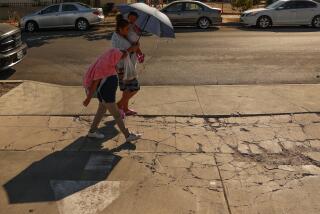Health Danger for Malibu Seen in Septic Tanks
A new Los Angeles County study has found that malfunctioning septic tanks and illegal discharges of waste water from beachfront homes pose a “significant” health hazard along a 13-mile strip of densely populated Malibu coastline.
The study, ordered by the Board of Supervisors a year ago after Malibu property owners angrily challenged the same conclusion in a previous survey, also found that septic systems at coastal businesses and apartment complexes are “significant public health problems.”
The findings by the Department of Health Services are important because they reinforce the department’s 1985 declaration that the tanks are a health hazard. That determination allows the county to impose a sewer system--with costly hook-up and construction fees--on Malibu without a vote of the community.
Leaders Critical
Several Malibu leaders immediately criticized the new study, citing past inaccuracies in health department reports and saying they are not convinced that Malibu’s septic tanks are a hazard.
“What I recommend is that you take that health department report with at least a grain of salt, if not a ton of salt,” said Leon Cooper, an executive board member of the Malibu Township Council, which represents more than 1,000 households.
Unlike past studies, however, this one does not seem likely to fuel much debate over whether the coastal community should have a large sewer system or a much smaller one.
Many community leaders and the Board of Supervisors now apparently agree that the community will wind up with something similar to the $34-million, small-scale sewer project recently recommended by a committee of Malibu residents, merchants and landowners.
An $86-million sewer proposal, championed by the county until 1,000 residents protested in the supervisors’ chambers last October, was hardly mentioned by the board last Tuesday, when it unanimously directed county staffers to continue to work with the committee on the scaled-down plan.
The citizens committee sidestepped the health hazard issue in its recommendations, seeking to avoid a split within the Malibu community. It concluded, nonetheless, that a sewer system is needed to accommodate growth and siphon waste water away from troubled landslide areas.
Sewer Plan Endorsed
In its new study, the health department endorses the committee’s sewer plan but does so for health reasons, said Robert Saviskas, who directed the study.
The health department worked with consultants hired by the citizens committee, providing the same detailed septic-tank information that is the basis for his department’s new report, Saviskas said.
“We couldn’t see how (the consultants) could come up with any other conclusion, regardless of who hired them,” he said. “We feel the information we’ve gathered over the last year is pretty overwhelming.”
Health department investigators studied all 1,372 private systems that treat sewage for 2,450 dwellings and many businesses along a 13-mile strip from Topanga Canyon west to Latigo Point.
They found relatively few health problems at inland areas such as Las Flores Mesa and Big Rock Mesa, where homes are generally newer, built on larger lots and meet current plumbing standards, the report said.
In contrast, investigators found that most septic tanks at the area’s 714 beach homes violated state standards in two key categories used to determine health hazards: The tanks were too close to the ground-water table, and waste water was pumped from the tanks too often.
Illegal Discharge Pipes
Investigators also found illegal discharge pipes--often installed under homes because overworked septic tank systems cannot adequately spread waste water in leach fields--at 225 of 526 beachfront dwellings where inspections were possible. Investigators were denied access to many other homes, the report said.
In addition, 35% of all 714 beach homes have had their sewage systems at least partially washed out in storms over the last 10 years, and more than one-fourth had aging systems that were functioning at less than 50% efficiency, the study said.
“One of the criticisms was that our (previous) statistical sample wasn’t large enough to make these kinds of conclusions. We’ve laid that to rest,” Saviskas said. “Literally every single address was investigated.”
More to Read
Sign up for Essential California
The most important California stories and recommendations in your inbox every morning.
You may occasionally receive promotional content from the Los Angeles Times.










